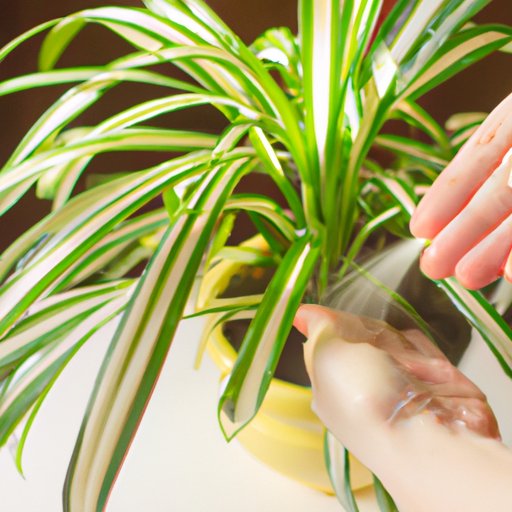Introduction
Spider plants are a popular houseplant for good reason — they’re easy to care for and look great in any indoor space. If you’ve just adopted a new spider plant and want to keep it healthy and growing, there are certain steps you’ll need to take. In this article, we’ll explore the basics of spider plant care, from providing bright indirect light to pruning dead leaves.
Provide Bright, Indirect Light
When it comes to spider plants, light is key. These plants prefer bright indirect light, meaning they should be placed near a window but not directly in the sun. An east or west-facing window is ideal since the sun won’t be too harsh. If you don’t have access to natural light, you can also use a grow light.
Aside from keeping your spider plant happy, proper lighting will also help it grow. Your plant should stay green and vibrant, and you may even notice more shoots and flowers appearing.
Water Regularly
Your spider plant will need regular watering to stay healthy. Generally speaking, you should water your plant once a week, allowing the soil to dry out between waterings. To check if your plant needs water, stick your finger into the soil — if it feels dry, it’s time to water.
Be careful not to over- or under-water your spider plant. Signs of overwatering include yellowing leaves and root rot, while underwatering can result in brown tips and wilting leaves. If you notice any of these signs, adjust your watering schedule accordingly.
Fertilize Every Two Weeks
Like all houseplants, spider plants benefit from a regular application of fertilizer. Choose a balanced houseplant fertilizer and apply it every two weeks during the growing season. You can also choose an organic fertilizer such as fish emulsion or liquid kelp.
Be sure to dilute the fertilizer to half the recommended strength before applying it to your spider plant. Fertilizing too often or with too much fertilizer can burn your plant.
Prune Dead Leaves
As your spider plant grows, you may notice some of the leaves turning yellow and dying off. This is normal, but it’s important to trim off any dead leaves so they don’t affect the health of your plant.
To prune your spider plant, use sharp scissors or gardening shears to snip off any yellow or brown leaves at the base. This will help encourage new growth and keep your plant looking its best.
Repot When Necessary
It’s a good idea to repot your spider plant every year or two. This will give the roots room to spread out and allow the plant to absorb more nutrients from the soil. Signs that your spider plant needs repotting include yellowing leaves, stunted growth, and roots poking out of the drainage holes.
When it’s time to repot, use a pot that’s one size larger than the current one and fill it with a high-quality potting mix. Be sure to water your plant thoroughly after repotting to help it settle in.
Conclusion
Taking care of a spider plant doesn’t have to be complicated. With the right light, water, and fertilizer, you can keep your plant thriving for years to come. Just remember to provide bright indirect light, water regularly, fertilize every two weeks, prune dead leaves, and repot when necessary.
With a bit of dedication and patience, you’ll soon have a beautiful and healthy spider plant to enjoy.


